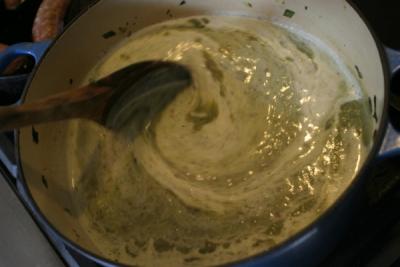I have enough trouble just remembering to write down a recipe after I create or adapt one for my tastes. Then, when I do, there is always the question of accuracy, as all too often I come back to it a month or year later and it just doesn't turn out. So, I find it more than just a little miraculous that barely a year has passed since I received and reviewed the Northern Heartland Kitchen cookbook by Dooley, and already, I am receiving emails asking me if I was interested in her newest piece of work, Minnesota's Bounty: The Farmer's Market Cookbook.
My initial reaction was, aren't all of her books really "farmer's market" cookbooks? I mean, she is one of the most outspoken proponents of all things locally grown. The concept challenged me to look closer and I noticed right away one of her trademark moments of brilliance: clever and unique organization. Whereas the Northern Heartland is organized nicely by season, this book is organized by vegetable (and fruit, cheese, grains and meat...but really, its about the vegetables). Keeping in mind the user, a typically impulsive farmer's market shopper, this structure makes total sense. More than that, it is exactly the first step in a possible conundrum faced by the average shopper, i.e. "This beautiful vegetable charmed me into buying it and now have no idea what the hell to do with it!"
Dooley not only embraces the idea of impulse shopping at markets, but she encourages it. In the beginning of the book, you will find a history of Minnesota farmers markets, as well as useful tips on how to get the most out of your trip. As a matter of fact, one of her tips is to "Forget the list". Well, now that we have a handy reference book, complete with tips and preparation help for each vegetable, we are a step closer to doing just that...and successfully!
My family often finds ourselves stuck in a state of wonder with our shopping indulgences: turnips, kohlrabi, and bok choy to name just a few. Searching out those veggies in Minnesota's Bounty, you are led to just a few tidy and simple ideas to transform them into quick and easy meals. This seemed to be the theme as a matter of fact. This book takes out the complication of many who spend their energy trying to Wow and Shock you with something totally new and surprising by providing real ideas rather than unobtainable masterpieces.
 Rhubarb Pandowdy
Rhubarb Pandowdy
This is totally apparent in the few dishes we tried. None had many ingredients and all were simple in terms of process. The Rhubarb Pandowdy for example is about as simple as it gets for a "pie". It takes just 5 ingredients for the filling (rhubarb, maple syrup, nutmeg, cinnamon, and salt) and the crust concept is made quite basic since you really just lay it right on top of the filling. If you aren't picky or are just learning, the thickness and quality of dough would matter even less, since by nature this is kind of a rustic looking pie. In the end, we were pleased enough with the idea, more than the recipe. It was the sort of thing you look at as a building block, a concept really. You learn how to make the simple, basic recipe and then modify and enhance. We immediately began imagining what we would do next time. Our first addition was just a bit of sugar. We love the concept of low or no sugar recipes, but rhubarb just begs for a bit of sweet to balance out its sour and tart nature. I'm sure we will be making this one all summer with revolving fruits.
 Stirring the cream into the soup.The leek and potato soup was our next venture. Ok, so leeks weren't available yet, but we did have way too many bunches of spring onions and happened upon some super early new potatoes at market. This dish seemed like the perfect and light accompaniment to the fresh baguette in our possession. With just 8 ingredients, but sturdy ones like chicken stock, heavy cream, and butter, this soup was quick, ready without a lot of bother, and boasted a nice rich and satisfying flavor. It was just perfect for a lazy weekend. It was a great idea.
Stirring the cream into the soup.The leek and potato soup was our next venture. Ok, so leeks weren't available yet, but we did have way too many bunches of spring onions and happened upon some super early new potatoes at market. This dish seemed like the perfect and light accompaniment to the fresh baguette in our possession. With just 8 ingredients, but sturdy ones like chicken stock, heavy cream, and butter, this soup was quick, ready without a lot of bother, and boasted a nice rich and satisfying flavor. It was just perfect for a lazy weekend. It was a great idea.
Finally, we decided to try a recipe called Spring Vegetable Ragout. This was due to our belief that we had an abundance of radishes and turnips, but as it turned out, we actually forgot to buy turnips at the market and ended up with local rutabagas from the co-op. Again, the recipe was pretty simple and I was curious about the term ragout…again. I only have to pretend to know something about a hundred times before I finally decide to go on a hunt for the answer. I wasn't going to utter another false, "ooooh I love ragouts." Pride be damned, I wanted to know what the heck a ragout was. I found a decidedly poignant answer on a Chicago Tribune question and answer forum that I have decided needs to be shared. In response to a reader wondering about the difference between ragouts and stews, it reads as follows:
"You might not be able to find much difference between a stew and a ragout in the recipe; but there`s a world of difference in the finished product. A ragout and a stew are basically the same thing--ragout is French for stew--but the French make their ragouts with extraordinary care which produces a particularly refined product. They add the meat first to broth or wine and skim the brown scum carefully before adding vegetables; then they watch the pot carefully, skimming fat, tasting the broth and generally fussing over it and coaxing it along. A ragout never boils--it simmers. And it simmers at so low a temperature that chefs say that when a ragout simmers it should merely smile. Another difference involves ingredients. The French never use water or boullion cubes: Wine or broth always makes for a more flavorful result. And instead of adding dried herbs directly to the stew the French make what is called a bouquet garni or a faggot. This is a little bundle of fresh herbs (consisting of such herbs as parsley, bay leaf, sprigs of fresh thyme and peppercorns) which is tied up into a cheesecloth and dropped into the stew; it is removed before serving. Still another difference has to do with the meat. As often as not, the French cut their ragout meat into large steak- sized slices, rather than 1 1/2-inch chunks like we do in America. And often, meat bones--which add gelatin and enrich the broth--are added to the stew, then removed before serving."
And so our kind Ms. Dooley has once again introduced us to simple new vegetables or concepts through tried and true process. As always, I tried to stay close to the simple recipe, but due to a lack of ingredients and a desire to use up a half head of radicchio, I took the side road. Wonderfully, this is all quite possible if you continue to abide by the simple procedures laid out by Dooley. Indeed, thanks to clear and uncomplicated instructions, we were left with a perfectly savory and delicious dish. My first experience with cooked radishes was outstanding. They were perfectly mellow and delicious, having kept their form and nature while absorbing the broth of the ragout beautifully. I would recommend this dish to anyone coming home from the market or otherwise. Once you have it in your repetoire, it wouldn't matter the season as long as you have butter, stock or wine and herbs, the dish would really make itself.
All in all, I can already see that this cookbook will become a fun resource when I need to brainstorm or want a little extra vegetable in my life (huh?) or come home with my hands full of bitter melon looking confused and slightly remorseful (fret no more, bitter melon buyers, there are 2 recipes for this as well in the book). I think that if all cookbooks were this simple, elegant and beautiful, we might all learn a bit more about food and be a bit less intimidated when it comes to cooking. Enjoy!

Spring Vegetable Ragout
Adapted from Minnesota's Bounty by Beth Dooley (with totally unauthorized additions!)
Serves 4
Ingredients
- 1 T butter
- 8 spring onions, halved
- 8 small turnips (or rutabegas) chopped.
- 5 radishes, chopped
- 5 carrots, sliced
- 2 sprigs thyme or other herb
- 1/4 c vegetable stock, chicken stock or white wine
- 2 c spinach (chopped if large)
- 1/2 small radicchio, sliced thin
- 1-2 T lemon juice
- salt/pepper
- 1/4 c basil
Instructions
- In a large skillet, melt the butter over medium-high heat. Saute the onions, turnips (rutabagas), radishes and carrots with the thyme (or creative fresh herb) for a few minutes.
- Add the stock, cover and reduce the heat to a very gentle simmer. Cook slowly until the vegetables are tender, about 10 minutes.
- Turn off, toss in the spinach and radicchio to wilt and season with salt, pepper and lemon juice. Toss in the basil and serve.

Lawrence Black is a writer and editor at Simple, Good, and Tasty. If someone made him choose between donuts and tacos, he would politely explain to the poor fool that there are three meals in a day and could they please get him some coffee...and then a beer.
He can be reached at: lawrence@simplegoodandtasty.com.

